Aegean › Minoan Civilization » Ancient origins
Articles and Definitions › Contents
- Aegean › Antique Origins
- Minoan Civilization › Ancient History
Ancient civilizations › Historical and archaeological sites
Aegean › Antique Origins
Definition and Origins
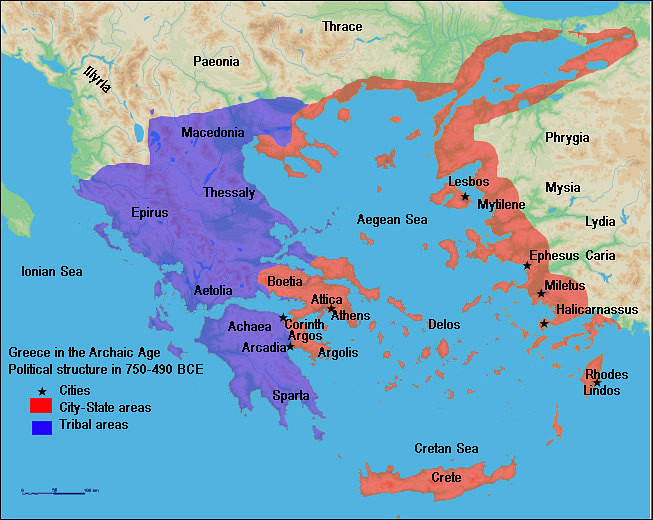
The Aegean Sea lies between the coast of Greece and Asia Minor (modern-day Turkey ). It contains over 2,000 islands which were settled by the ancient Greeks; the largest among them being Crete (Kriti) and the best known and most often photographed, Santorini ( Thera or Thira). Both of these islands have strong associations with ancient Greek history and myth in that Crete features significantly in the myth of Theseus and the Minotaur while the destruction of Santorini by a volcano eruption has long been considered a probable source for Plato 's description of Atlantis in his dialogues of the Critias and Timaeus.
NAME ORIGIN
In ancient times there were various explanations for the name Aegean. It was said to have been named after the Greek town of Aegae, or after Aegea, a queen of the Amazons who died in the sea, or Aigaion, the "sea goat", another name of Briareus, one of the archaic Hecatonchires, or, especially among the Athenians, Aegeus, the father of Theseus, who drowned himself in the sea when he thought his son had died on his famous expedition to Crete to defeat the Minotaur. A possible etymology is a derivation from the Greek word αἶγες – aiges = "waves" (Hesychius of Alexandria ; metaphorical use of αἴξ (aix) "goat"), hence "wavy sea", cf. also αἰγιαλός (aigialos) "coast".
THE AEGEAN SEA FEATURES PROMINENTLY IN MANY OF THE MOST FAMOUS GREEK MYTHS.
AEGEAN TRADE
The early inhabitants of Greece, the Mycenaens, relied heavily on the Aegean for trade and, it seems, traveled as far as Spain and Egypt. Commercial sea trading became their main source of income and, in time, they colonized the various islands of the Aegean archipelago and produced various commodities such as figs, grapes, wine, raisins, honey, wheat, assorted vegetables, and herbs. Marble, especially, became an important export in trade. This produce, along with that of the mainland, went to make the merchants of ancient Greece wealthy but the same waters on which they relied for their wealth and livelihood became the avenue for their downfall.
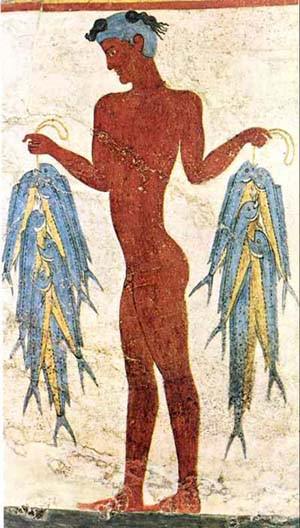
Fisherman Fresco, Akrotiri
SEA PEOPLES
In about 1200 BCE the Mycenaean civilization collapsed and, while no one cause is universally agreed upon, it is considered very likely that they succumbed to the same mysterious invaders who ravaged Egypt and Anatolia : The Sea Peoples.Whoever the Sea Peoples were, they are documented as harrassing the Egyptians, the Hittites, the Greeks, and the Phoenicians (Canaanites) until finally settling along the coast of Canaan and acquiring the name Philistines. There is no doubt among scholars, based upon primary sources, that the Sea Peoples came to Greece from the south on the Aegean Sea and ravaged the coastline, making incursions on to the mainland and seizing islands. Shortly after their arrival, the Dorians descended from the north of Greece and the Mycenaean civilization was over (though some scholars have speculated that Mycenaen culture was kept alive through those Greeks who would eventually found Athens while Sparta proudly claimed Doric ancestry). Greek civilization as recognized today grew out of the aftermath of the Dorian invasion. It is interesting to note, if one believes that the Mycenaean culture survived through Athens, that the Greek colonies of Asia Minor were largely settled by Athenians. The poet Homer is said to have come from one of these Greek colonies and the famous heroes of his Iliad, arguably the most popular and influential work of its time, are all Mycenaeans.
IN MYTHOLOGY
The Aegean Sea features prominently in many of the most famous Greek myths (Icarus and Daedelus, Theseus and the Minotaur, Jason and the Argonauts, The Odyssey, among others) and Plato made ample use of the islands in his dialogues.In his Euthyphro, for example, Plato purposefully has the young man who claims to know everything come from the island of Naxos which was known be the most prosperous and the residents quite wealthy and condescending. According to Herodotus, the island of Naxos was the most prosperous in trade c. 500 BCE and was easily able to pay tribute to Athens in the form of gold rather than military aid after the islands' failed attempt to leave the Delian League in 476 BCE. In the Golden Age of Greece and beyond, the Aegean Sea continued to serve an important function in trade and in war, helping the Greek culture and civilization to flourish until the Romans, like the Sea Peoples before them, employed the waterways for conquestand subdued Greece.
Minoan Civilization › Ancient History
Definition and Origins
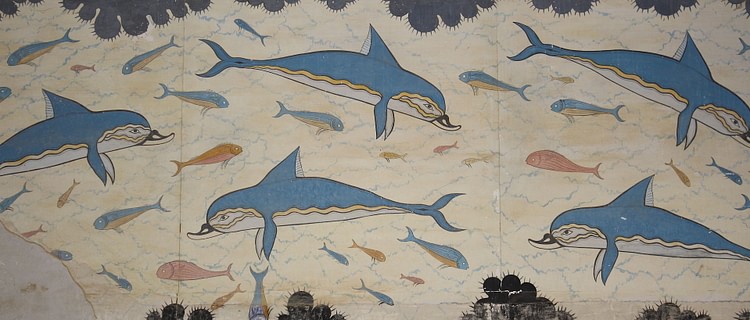
The Minoan civilization flourished in the Middle Bronze Age on the island of Crete located in the eastern Mediterranean from c. 2000 BCE until c. 1500 BCE. With their unique art and architecture, and the spread of their ideas through contact with other cultures across the Aegean, the Minoans made a significant contribution to the development of Western European civilization as it is known today. Labyrinth -like palace complexes, vivid frescoes depicting scenes such as bull-leaping and processions, fine gold jewellery, elegant stone vases, and pottery with vibrant decorations of marine life are all particular features of Minoan Crete.
ARTHUR EVANS & DISCOVERY
The archaeologist Sir Arthur Evans was first alerted to the possible presence of an ancient civilization on Crete by surviving carved seal stones worn as charms by native Cretans in the early 20th century CE. Excavating at Knossos from 1900 to 1905 CE, Evans discovered extensive ruins which confirmed the ancient accounts, both literary and mythological, of a sophisticated Cretan culture and possible site of the legendary labyrinth and palace of King Minos. It was Evans who coined the term Minoan in reference to this legendary Bronze Age king. Evans, seeing what he believed to be the growth and decline of a unified culture on Crete, divided the island's Bronze Age into three distinct phases largely based on different pottery styles:
- Early Bronze Age or Early Minoan (EM): 3000-2100 BCE
- Middle Bronze Age or Middle Minoan (MM): 2100-1600 BCE
- Late Bronze Age or Late Minoan (LM): 1600-1100 BCE
The above divisions were subsequently refined by adding numbered subphases to each group (eg MM II). Radio-carbon dating and tree-ring calibration techniques have helped to further refine the dates so that the Early Bronze Age now begins c.3500 BCE and the Late Bronze Age c. 1700 BCE. An alternative to this series of divisions, created by Platon, instead focuses on the events occurring in and around the major Minoan “palaces”. This scheme has four periods:
- Prepalatial: 3000 - 2000/1900 BCE
- Protopalatial: 2000/1900 - 1700 BCE
- Neopalatial: 1700 - 1470/1450 BCE
- Postpalatial: 1470/1450 - 1100 BCE
Both of these schemes have since been challenged by more modern archaeology and approaches to history and anthropology in general which prefer a more multilinear development of culture on Crete with a more complex scenario involving conflicts and inequalities between settlements and which also considers their cultural differences as well as their obvious similarities.
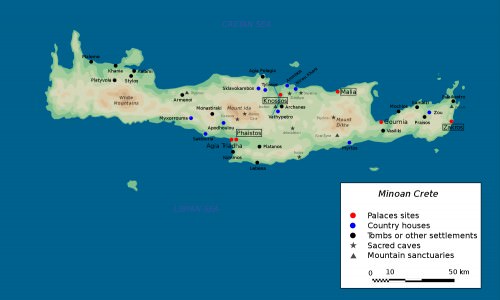
Map of Minoan Crete
MINOAN PALACE SETTLEMENTS
Minoan settlements, tombs, and cemeteries have been found all over Crete but the four principal palace sites (in order of size) were:
- Knossos
- Phaistos
- Malia
- Zakros
MINOAN PALACES EXERTED SOME KIND OF LOCALISED CONTROL, IN PARTICULAR, IN THE GATHERING & STORAGE OF SURPLUS MATERIALS.
At each of these sites, large, complex palace structures seem to have acted as local administrative, trade, religious, and possibly political centres. The relationship between the palaces and the power structure within them or over the island as a whole is not clear due to a lack of archaeological and literary evidence. It is clear, however, that the palaces exerted some kind of localised control, in particular, in the gathering and storage of surplus materials - wine, oil, grain, precious metals and ceramics. Small towns, villages, and farms were spread around the territory seemingly controlled by a single palace. Roads connected these isolated settlements to each other and the main centre. There is a general agreement among historians that the palaces were independent from each other up to 1700 BCE, and thereafter they came under the sway of Knossos, as evidenced by a greater uniformity in architecture and the use of Linear A writing across various palace sites.
The absence of fortifications in the settlements suggests a relatively peaceful co-existence between the different communities.However, the presence of weapons such as swords, daggers, and arrowheads, and defensive equipment such as armour and helmets would also suggest that peace may not always have been enjoyed. Minoan roads, too, have evidence of regular guardhouses and watchtowers suggesting that banditry, at least, troubled the unprotected traveller.
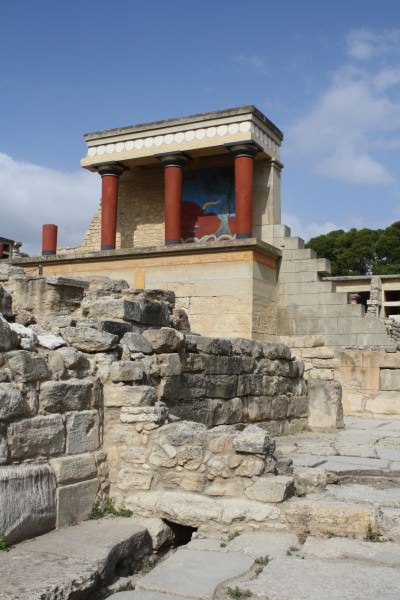
Palace of Knossos
The palaces themselves covered two periods. The first palaces were constructed around 2000 BCE and, following destructive earthquakes and fires, rebuilt again c. 1700 BCE. These second palaces survived until their final destruction between 1500 BCE and 1450 BCE, once again by either earthquake, fire, or possibly invasion (or a combination of all three). The palaces were well-appointed, monumental structures with large courts, colonnades, ceilings supported by tapered wooden columns, staircases, religious crypts, light-wells, extensive drainage systems, large storage magazines and even 'theatre' areas for public spectacles or religious processions.
DEPICTIONS OF DOUBLE AXES (OR LABRYS) & THE COMPLEX PALACES MAY HAVE COMBINED TO GIVE BIRTH TO THE LEGEND OF THESEUS & THE LABYRINTH-DWELLING MINOTAUR.
Reaching up to four stories high and spreading over several thousand square metres, the complexity of these palaces, the sport of bull-leaping, the worship of bulls as indicated by the presence throughout of sacred bulls' horns and depictions of double axes (or labrys ) in stone and fresco may all have combined to give birth to the legend of Theseus and the labyrinth-dwelling Minotaur so popular in later classical Greek mythology.
RELIGION
The religion of the Minoans remains sketchy, but details are revealed through art, architecture, and artefacts. These include depictions of religious ceremonies and rituals such as the pouring of libations, making food offerings, processions, feasts, and sporting events like bull-leaping. Natural forces and nature in general, manifested in such artworks as a voluptuous female mother-earth goddess figure and male figure holding several animals, seem to have been revered. Palaces contain open courtyards for mass gatherings and rooms often have wells and channels for the pouring of libations, as previously noted. As already mentioned, too, bulls are prominent in Minoan art, and their horns are an architectural feature of palace walls and a general decorative element in jewellery, frescoes, and pottery decoration. Dramatic rural sites such as hilltops and caves often show evidence of cult rituals being performed there.
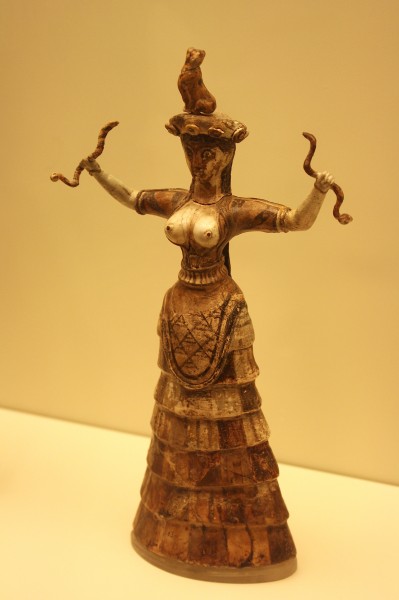
Minoan Snake Goddess, Knossos.
MATERIAL CULTURE
The sophistication of the Minoan culture and its trading capacity is evidenced by the presence of writing, firstly Cretan Hieroglyphic (c. 2000-1700 BCE) and then Linear A scripts (both, as yet, undeciphered), predominantly found on various types of administrative clay tablets. Seal impressions on clay were another important form of record keeping.
A further example of the culture's high degree of development is the variety and quality of the art forms practised by the Minoans. Pottery finds reveal a wide range of vessels from wafer-thin cups to large storage jars ( pithoi ). Ceramics were initially hand-turned but then increasingly made on the potter's wheel. In decoration, there was a progression from flowing geometric designs in Kamares ware to vibrant naturalistic depictions of flowers, plants, and sea life in the later Floral and Marine styles. Common pottery shapes include three-handled amphorae, tall beaked-jugs, squat round vessels with a false spout, beakers, small lidded boxes, and ritual vessels with figure-of-eight-shaped handles. Stone was also used to produce similar vessel types and rhyta (ritual vessels for pouring libations, often in the shape of animal heads).
Large-scale figure sculpture has not survived but there are many figurines in bronze and other materials. Early types in clay show the dress of the time with men (coloured red) wearing belted loincloths and women (coloured white) in long flowing dresses and open-fronted jackets. A leaping acrobat in ivory and the faience snake goddess already mentioned are notable works which reveal the Minoan love of capturing figures in active striking poses.
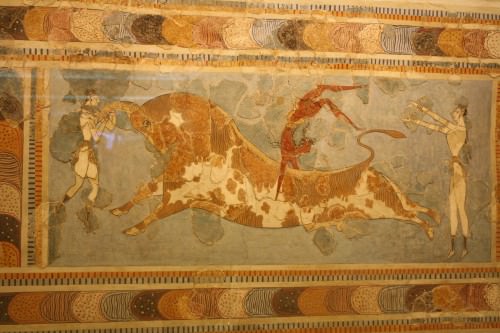
Minoan Bull Leaping
Magnificent frescoes from the walls, ceilings, and floors of the palaces also reveal the Minoans' love of the sea and nature and give insights into religious, communal, and funeral practices. Subjects range in scale from miniature to larger-than-life size.The Minoans were one of the earliest cultures to paint natural landscapes without any humans present in the scene; such was their admiration of nature. Animals, too, were often depicted in their natural habitat, for example, monkeys, birds, dolphins, and fish. Although Minoan frescoes were often framed with decorative borders of geometric designs, the principal fresco itself, on occasion, went beyond conventional boundaries such as corners and covered several walls of a single room, surrounding the viewer.
MINOAN ARTISTS, ESPECIALLY FRESCO PAINTERS, TOOK THEIR SKILLS TO THE ROYAL PALACES OF EGYPT & THE LEVANT.
AEGEAN CONTACTS
The Minoans, as a seafaring culture, were also in contact with foreign peoples throughout the Aegean, as evidenced by the Near Eastern and Egyptian influences in their early art but also in the later export trade, notably the exchange of pottery and foodstuffs such as oil and wine in return for precious objects and materials such as copper from Cyprus and Attica and ivory from Egypt. Several Aegean islands, especially in the Cyclades, display the characteristics of a palace-centred economy and political structure as seen on Crete while Minoan artists, especially fresco painters, took their skills to the royal palaces of Egypt and the Levant.
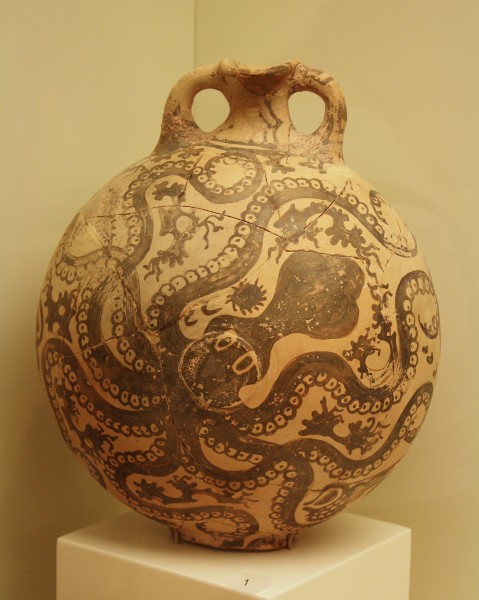
Minoan Vase in Marine Style
DECLINE
The reasons for the demise of the Minoan civilization continue to be debated. Palaces and settlements show evidence of fire and destruction c. 1450 BCE, but not at Knossos (which was destroyed perhaps a century later). The rise of the Mycenaean civilization in the mid-2nd millennium BCE on the Greek mainland and the evidence of their cultural influence on later Minoan art and trade make them the most likely cause. However, other suggestions include earthquakes and volcanic activity with a consequent tsunami. The eruption of Thera (the present-day island of Santorini) may have been particularly significant, although, the exact date of this cataclysmic eruption is disputed and therefore its connection with the end of the Minoan period remains unclear. The most likely scenario was probably a fatal mix of natural environmental damage and competition for wealth weakening the structure of society, which was then exploited by invading Mycenaeans. Whatever the cause, most of the Minoan sites were abandoned by 1200 BCE and Crete would not return to the Mediterranean stage of history until the 8th century BCE when it was colonised by Archaic Greeks.
MAP
LICENSE:
Article based on information obtained from these sources:with permission from the Website Ancient History Encyclopedia
Content is available under License Creative Commons: Attribution-NonCommercial-ShareAlike 3.0 Unported. CC-BY-NC-SA License